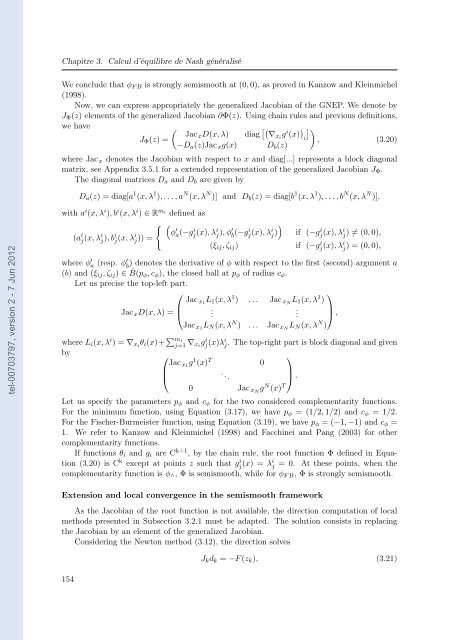Etude des marchés d'assurance non-vie à l'aide d'équilibres de ...
Etude des marchés d'assurance non-vie à l'aide d'équilibres de ...
Etude des marchés d'assurance non-vie à l'aide d'équilibres de ...
Create successful ePaper yourself
Turn your PDF publications into a flip-book with our unique Google optimized e-Paper software.
tel-00703797, version 2 - 7 Jun 2012<br />
Chapitre 3. Calcul d’équilibre <strong>de</strong> Nash généralisé<br />
We conclu<strong>de</strong> that φF B is strongly semismooth at (0, 0), as proved in Kanzow and Kleinmichel<br />
(1998).<br />
Now, we can express appropriately the generalized Jacobian of the GNEP. We <strong>de</strong>note by<br />
JΦ(z) elements of the generalized Jacobian ∂Φ(z). Using chain rules and previous <strong>de</strong>finitions,<br />
we have<br />
<br />
Jac<br />
JΦ(z) =<br />
xD(x, λ) diag ∇xigi (x) <br />
i , (3.20)<br />
−Da(z)Jac xg(x) Db(z)<br />
where Jac x <strong>de</strong>notes the Jacobian with respect to x and diag[...] represents a block diagonal<br />
matrix, see Appendix 3.5.1 for a exten<strong>de</strong>d representation of the generalized Jacobian JΦ.<br />
The diagonal matrices Da and Db are given by<br />
Da(z) = diag[a 1 (x, λ 1 ), . . . , a N (x, λ N )] and Db(z) = diag[b 1 (x, λ 1 ), . . . , b N (x, λ N )],<br />
with ai (x, λi ), bi (x, λi ) ∈ Rmi <strong>de</strong>fined as<br />
(a i j(x, λ i j), b i j(x, λ i <br />
j)) =<br />
φ ′ a(−gi j (x), λij ), φ′ b (−gi j (x), λij )<br />
<br />
if (−gi j (x), λi j ) = (0, 0),<br />
(ξij, ζij) if (−gi j (x), λij ) = (0, 0),<br />
where φ ′ a (resp. φ ′ b ) <strong>de</strong>notes the <strong>de</strong>rivative of φ with respect to the first (second) argument a<br />
(b) and (ξij, ζij) ∈ ¯ B(pφ, cφ), the closed ball at pφ of radius cφ.<br />
Let us precise the top-left part.<br />
⎛<br />
Jac xD(x, λ) =<br />
⎜<br />
⎝<br />
Jac x1 L1(x, λ 1 ) . . . Jac xN L1(x, λ 1 )<br />
.<br />
Jac x1 LN(x, λ N ) . . . Jac xN LN(x, λ N )<br />
where Li(x, λi ) = ∇xiθi(x)+ mi j=1 ∇xigi j (x)λij . The top-right part is block diagonal and given<br />
by<br />
⎛<br />
Jac x1<br />
⎜<br />
⎝<br />
g1 (x) T 0<br />
. ..<br />
0 Jac xN gN (x) T<br />
⎞<br />
⎟<br />
⎠ .<br />
Let us specify the parameters pφ and cφ for the two consi<strong>de</strong>red complementarity functions.<br />
For the minimum function, using Equation (3.17), we have pφ = (1/2, 1/2) and cφ = 1/2.<br />
For the Fischer-Burmeister function, using Equation (3.19), we have pφ = (−1, −1) and cφ =<br />
1. We refer to Kanzow and Kleinmichel (1998) and Facchinei and Pang (2003) for other<br />
complementarity functions.<br />
If functions θi and gi are Ck+1 , by the chain rule, the root function Φ <strong>de</strong>fined in Equation<br />
(3.20) is Ck except at points z such that gi j (x) = λij = 0. At these points, when the<br />
complementarity function is φ∧, Φ is semismooth, while for φF B, Φ is strongly semismooth.<br />
Extension and local convergence in the semismooth framework<br />
As the Jacobian of the root function is not available, the direction computation of local<br />
methods presented in Subsection 3.2.1 must be adapted. The solution consists in replacing<br />
the Jacobian by an element of the generalized Jacobian.<br />
Consi<strong>de</strong>ring the Newton method (3.12), the direction solves<br />
154<br />
.<br />
⎞<br />
⎟<br />
⎠ ,<br />
Jkdk = −F (zk), (3.21)
















